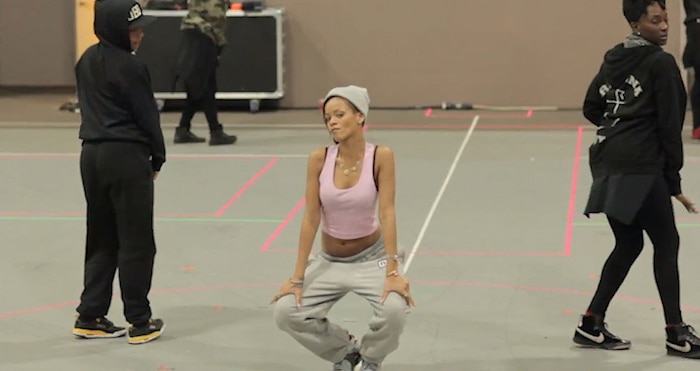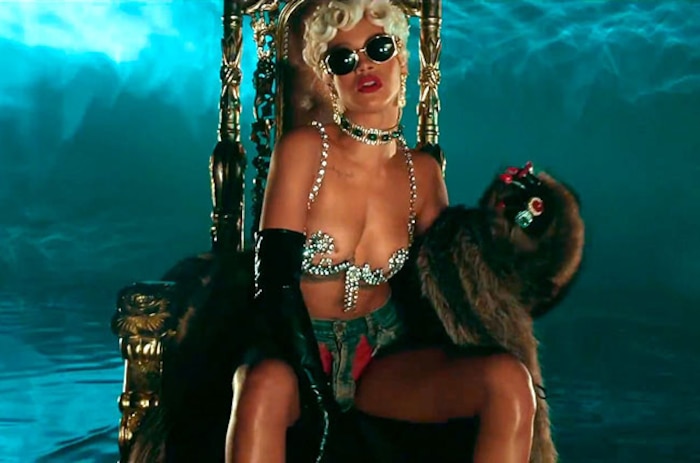All I See Is Controversy: Rihanna’s “Pour It Up”
The R&B singer’s provocative video has set off a conversation about exploitation and misogyny in the music industry. Melissa Bradshaw says it isn’t.

It’s funny there’s been so much critique of the video for Rihanna’s song “Pour It Up” without anybody doing much talking to her – or any of the four women in her video. Doesn’t this itself “objectify,” by treating them as objects without voices? I recently spoke to one of the dancers, Nicole “The Pole” Williams. She feels exactly the opposite of exploited by Rihanna, who released a video of Williams’ audition for “Pour It Up” a few days before releasing the official clip for the song.
“The fact that she singled me out and made that video was a blessing and I’m so grateful for it.”
“The fact that she singled me out and made that video was a blessing and I’m so grateful for it,” says Nicole. “She could have put up the video and just said it was a pole dancer from the video. She didn’t have to put my name in it and give me all this notoriety. It’s just been great.” Nicole told me negative critics of the video for “Pour It Up” are, well, just negative. “The video is about the fun, and about the movement, and about throwing up money!” she exclaimed over the phone. “It’s a strip club song. It’s not like she was doing that type of video to a love song. If you know it’s about strip clubs and you don’t like strippers, then don’t watch it. That way you don’t have to get offended!”

The video has been singled out by many for exemplifying what is variously referred to as the “sexualisation” or “objectification” of women in music videos, as well as misogyny in the music industry. This connection between women behaving sexually and misogyny in the music industry is the sign of a snobby attitude towards women who behave sexually. In a BBC Radio 4 special, prior to the Peel lecture in which she criticized Rihanna and the music industry’s portrayal of women as “juvenile” and “hypersexual,” Charlotte Church contrasted the “Pour It Up” video with the clip for Björk’s “Pagan Poetry,” which she described as “beautiful.” Church said, “I suppose a part of it is also can sex be art, and yet it absolutely can,” implying that Rihanna’s video was something else. BBC Radio One presenter Jameela Jamil has also recently said (in a tweet to me, in a conversation following a blog post she wrote) that Lily Allen’s video for “Hard Out Here” is a parody of the “exploitation” of black “girls” in the “Pour It Up” video.
“There’s nothing demeaning about me doing something athletic on a pole.”
The idea that “Pour It Up” is not art, and making such videos is stupid or immature, reverts to the unfortunate trope of black people and black culture being aesthetically and ethically inferior. I felt this was inherent at the beginning of the entire recent discussion about the “sexualisation” of women in music videos, which is why I decided to talk to Nicole: Why not hear what one of the women in the video had to say? I did the interview weeks before Lily Allen’s video came out. Ironically, I was told by editors at some non-music mainstream publications that they couldn’t see the point of it, and it was “too late,” as the discussion had died down.
“There’s a lot of other things that are happening in the world that are a little more demeaning to women,” Nicole pointed out. “There’s nothing demeaning about me doing something athletic on a pole. I’m doing the same thing that you would see a gymnast do in a gymnastics competition. I have on the same outfit that you will see me wearing on the beach.” Misdirected indeed. The furore has been characteristic of black music sending white mainstream into a frenzy. The convenient depiction of black men as promiscuous, lascivious and sexually dangerous, threatening white men’s exclusive claim to white women, was described by Frantz Fanon in Black Skin, White Masks, back in 1952. Later in the same decade Elvis Presley’s reinterpretation of the blues had the Catholic Church writing warnings to the FBI, and Ray Charles’ audiences going crazy to the fusion of sex and gospel in his song “What’d I Say.” Disco Demolition Night, 2 Live Crew, Miley Cyrus the twerking victim… mainstream American and European culture has repeatedly gotten hysterical over sex and black music.

Assuming that women behaving sexually is always an outcome of patriarchal misogyny is laughable, especially so in the case of “Pour It Up.” Watch closely and Nicole’s skill and agility are remarkable as she holds herself horizontally, vertically, contorting catlike down the poles. Rihanna took lessons from Nicole prior to shooting, which Rihanna broadcast on her Instagram. And then a few days before releasing her own video, Rihanna also released the video of Nicole’s audition. Nicole’s acrobatics in the audition tape are truly badass: Nobody could say the way she slides face down the pole and catches herself with only her legs isn’t powerful. Or claim that how she appears to sit down on the ceiling (with no hands) is not creative and artful. She performs the kinds of feats we would normally associate with fictional superheroes.
There are four other dancers in the “Pour It Up” video: Asha Franklin, Secret Moneii, and Candace Cane (also a pole dancer), and its choreographer, Oth’than Burnside. In the song, Rihanna constantly refers to a “we.” (“Pour it up pour it up, that’s how we ball out.”) All this gives me a strong impression not of exploitation, but of sisterhood. And, as Nicole pointed out, Rihanna has helped to raise the profile of pole dancing. “You’re seeing a lot of people more interested in pole [dancing] now, and seeing it in a different light, realising that it’s athletic, it’s artistic, it’s really beautiful, it’s not about stripping or shaking your booty.”
In the song, Rihanna constantly refers to a “we.” This gives me a strong impression not of exploitation, but of sisterhood.
Before the video’s release Nicole was already a successful entrepreneur. A former athlete (“any sport with a ball, that’s what I loved to do”) and personal trainer, she started pole dancing seven years ago after she went to a house party where two girls set up a pole and started performing tricks on it. “Really fancy stuff. I remember going, ‘Oh my god! Can you guys show me?’” She put up a pole at home and taught herself from YouTube videos. She says she had to learn the art of being sexy. She would send videos of herself to her male friends. “They’d be like, erm, well you’re strong, you got the tricks! But it doesn’t look sexy. You need to work on that.” Then she and her business partner closed their gym and Nicole began teaching pole dance – first from her home, then in a rented space and finally with her own storefront. She says she has taught literally thousands of women.
Pole dancing has a history that goes back way past its incorporation into strip clubs: nowadays there are both strippers who do proper pole dance and pole dancers who aren’t strippers. Rihanna’s video showcases both, but as Nicole repeated, that’s because it’s a strip club song. But to point out that “Pour It Up” is a strip club song doesn’t just mean it’s a song about strip clubs. It also means that it participates in a subgenre of rap and R&B.
Compare “Pour It Up” with the video for Meek Mill’s “Face Down,” which showcases a less sophisticated portrayal of pole dancing, and a refrain that includes the line “there’s some hoes in this house, trying to fuck.” It’s the rapper’s fantasy of being surrounded by sexually available women. Rihanna’s song and video is a witty and strong response. Here, the women are making the money, with Rihanna’s money-obsessed persona singing “all I see is signs, all I see is dollar signs.” I’ve honestly been astounded by people’s obliviousness to this chorus. (Doesn’t that, again, ironically “objectify” Rihanna, by not hearing what she’s saying?) The only man that gets any kind of mention in the “Pour It Up” video is Jay Z – and only in passing. There are plenty of examples of “sexualisation” in videos by Rihanna’s male peers but – except when they allude or appear to allude to rape – they don’t attract the same intense attacks. I wonder if that’s because, for a woman, Rihanna has become too powerful?
Yes, there needs to be a critique of the treatment of women as sexual currency. And Nicole agrees that the strip club industry can have a more sinister side, but so does every industry, she points out. “You have mayors and governors who are sending pictures of his penis to people, and things like that, you know what I mean? You have husbands beating their wives and they don’t work at strip club, but there’s this violence that goes on.”
It’s Rihanna who sits on the throne.
There’s also a huge problem with lumping together all types of sexualised behaviour. Bonnie Sherr Klein’s passionate 1981 documentary Not a Love Story, for instance, connected live strip clubs to photographic and cinematic porn, ending with a vision in which there is only a desire for domination in men, and rage in women. In it, you can also see women blaming other women who do any kind of stripping for all of pornography’s violent fantasies, and for men making money out of women. “Again,” says Nicole. “that opinion is so not valid.”
Nicole explains that she thinks Rihanna just wanted to have fun with the video. “It was about that song, and she really wanted to just have fun and shake her butt, and get to live out that stripper fantasy. And we all did it!” If I’m slightly dubious about Nicole’s assertion that, as she puts it, “pretty much most women I know” have a fantasy of being on a strip club stage, it’s important to recognise that women can both internalise an idea of themselves as sexual currency, and make it something powerful by acting out their own fantasies.
I think that “Pour It Up” works as a witty, ironic embodiment of women as sexual currency. If you can see that “Pour It Up” is about sisterhood, and combines women behaving sexually, being seen as sexy and making money together, you can also see why women appearing in videos as objects and misogyny do not have to be connected. In my opinion, assuming a necessary connection between women behaving sexually and misogyny is obviously a function of antifeminist patriarchy. “Pour It Up” shows women behaving sexually without a patriarchy. It’s Rihanna who sits on the throne. Beauty and sex may have become a currency, but women can participate in – and enjoy – that currency, too.